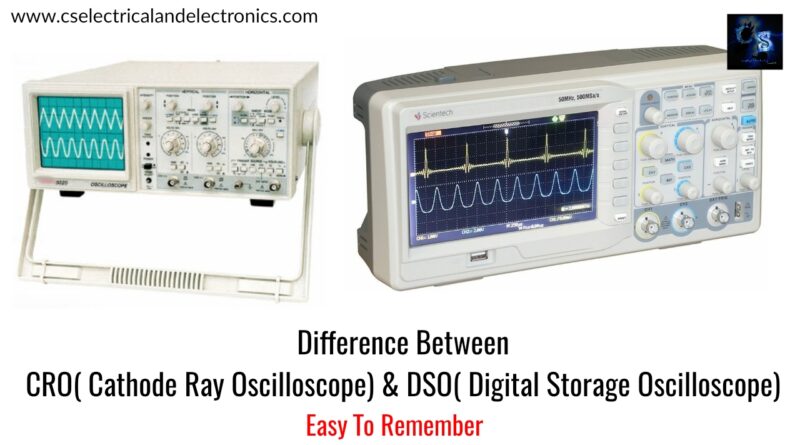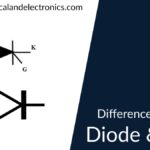Difference between CRO and DSO, Cathode Ray And Digital Storage
Hello guys, welcome back to my blog. In this article, I will discuss the difference between CRO and DSO, the difference between the cathode-ray oscilloscope and digital storage oscilloscope, etc.
If you need an article on some other topics then comment us below in the comment box. You can also catch me @ Instagram – Chetan Shidling.
Also, read:
- Difference Between Analog And Digital Measurements.
- Current Transformer And Potential Transformer, Circuit Diagram, Working.
- Difference Between LT, HT, And Transmission Lines, Conductors Used.
Difference between CRO and DSO
An oscilloscope is an electronic test instrument that graphically displays varying signal voltages. The displayed waveform can be analyzed for properties such as amplitude, time interval, frequency, distortions, rise time, etc. To calculate all these properties we need to take the values from the output waveform. The oscilloscope can be adjusted so that repetitive signals can be observed as a persistent waveform on the screen. In earlier days we call an oscilloscope as oscillograph and informally known as CRO(Cathode Ray Oscilloscope) and for modern applications, we use another oscilloscope called DSO(Digital Storage Oscilloscope).
Cathode Ray Oscilloscope (CRO)

Cathode Ray Oscilloscope is one of the devices which is employed to display the output waveform. It consists of Cathode Ray Tube(CRT), vertical amplifier, horizontal amplifier, timebase, electrode, and power supply. The CRT is the heart of CRO. When CRO is switched on, a CRT displays one bright dot within the center of the screen, but the dot is often moved about electrostatically and magnetically. Between the electrode and the screen, there are two opposed pairs of metal plates called the deflection plates.
The vertical amplifier produces the voltage across one pair of plates, giving rise to a vertical field through which the beam passes. When the plate potentials are equivalent, the beam isn’t deflected. When the highest plate is positive with reference to the rock bottom plate, the beam is deflected upwards. When the sector is reversed, the beam is deflected downwards. The horizontal amplifiers do the same function with the opposite pair of deflection plates, causing the beam to move to the left or right. The facility supply is a crucial component of the oscilloscope.
It provides low voltages and high voltages for all the components that are present within the oscilloscope. Higher voltages needed to drive the electrostatic deflection plates, which suggests that the output stage of the vertical deflection amplifier possesses to develop large signal swings. These voltages should be more stable and amplifier gain must be correspondingly stable. Later analog oscilloscopes added digital Processing to the standard design.

The Digital Storage Oscilloscope is little in size and is now the preferred type for many industrial applications. Rather then storage type beam tubes, DSOs use digital memory, which may store data as long as needed without degradation. A digital storage oscilloscope is able to allow difficult processing of the signal by high-speed digital signal processing circuits. The vertical input is digitized by an analog to digital converter to make a knowledge set that’s stored within the memory of a microprocessor.
The data set is processed and then sent to the display, which in early DSOs was a cathode ray tube but today may be an LCD flat panel. The sampling data set are often stored to internal storage over a LAN for archiving. A screen image is additionally be saved to internal, without the necessity for an oscilloscope camera. The oscilloscope’s own signal analysis software can extract many useful time-domain features.
Differences between CRO and DSO
| CRO | DSO |
| CRO is an analog oscilloscope and it cannot store signals. | DSO is a digital oscilloscope. DSO stores and analyzes the signals digitally. |
| CRO stands for Cathode Ray Oscilloscope. | DSO stands for Digital Storage Oscilloscope. |
| Cathode Ray Oscilloscope used a normal triggering circuit. | Digital Storage Oscilloscope has an advanced triggering circuit. |
| Simple Cathode Ray Oscilloscope does not have any memory. | Digital Storage Oscilloscope has memory. |
| Manipulations are not possible at any time because there is no availability of reading out memory. | Manipulations are possible at any time because of readout memory is available in the DSO. |
| CRO does not have a USB 2.0 port. | DSO has a USB 2.0 port. |
| Computers and printers don’t attached because it doesn’t have USB. | The computers and printer is attached using a USB port. |
| CRO measures but doesn’t display the properties. | DSO measures and displays all properties of the waveform. |
| CRO has a higher writing speed and higher bandwidth. | DSO has a lower bandwidth and limited speed. |
| Cathode ray oscilloscope has a tube called CRT, it needs replacement after a few days. So, it is more costly. | Digital Storage Oscilloscope has an LCD flat panel. |
| It is less stable and accurate because the time base is generated by the ramp circuit. | It is more stable and accurate because the time base is generated by a crystal clock. |
| It doesn’t have any back mode but Collects data after triggered. | It has back mode because it stores the data. |
| There is no storage system so, no chance to archive the data. | Here, there is a chance to archive the data because it has a storage memory. |
I hope this article may help you all a lot. Thank you for reading. If you have any doubts related to this article “difference between CRO and DSO”, then comment below in the comment box.
Also, read:
- 100 + Electrical Engineering Projects For Students, Engineers
- 1000+ Electronics Projects For Engineers, Diploma, MTech Students
- 1000+ MATLAB Simulink Projects For MTech, Engineering Students
- 500+ Embedded System Projects For Engineer, Diploma, MTech, PhD
- 500+ Projects For Diploma Electrical, Electronics Student, Diploma Project
- 8051 Microcontroller Timers, TCON Register, TMOD Register
- Advancements In 3D Printing Technology And It’s Future
- Advancements In Power Electronics For Energy Efficiency
- AI Tools For Electronic Circuit Design, Which Is Best?
- Analog Electronics Interview Questions Most Commonly Asked
- Applications Of IoT, Internet Of Things, What Is IoT, Latest Technology
- Applications Of Microcontrollers, Embedded System Applications
- Automotive Electronics Interview Questions For Engineers, Automobile
- Automotive Industry Or VLSI Chip Industry ? Which Is Best?
- Autonomous Vehicles: The Future Of Transportation
- Best Engineering Branch For Future
- Best Programming Languages For Electrical and Electronics Engineers
- Cadence Technical Interview Questions For EE And EC Students
- CAN Protocol Tutorial, Working, Frames, Interview Q’s, Errors
- Difference Between .Hex .Bin .Elf .Axf Files, Purpose, Examples
Author Profile
Latest entries
 All PostsJanuary 21, 2021Different Types of Tesla Electric Cars, Tesla Cars Models
All PostsJanuary 21, 2021Different Types of Tesla Electric Cars, Tesla Cars Models All PostsNovember 2, 2020Difference Between Earthing and Grounding, Definition
All PostsNovember 2, 2020Difference Between Earthing and Grounding, Definition All PostsSeptember 27, 2020Differences Between Electric Cars and Diesel cars, History
All PostsSeptember 27, 2020Differences Between Electric Cars and Diesel cars, History All PostsSeptember 27, 2020Difference Between Diode and SCR (Silicon Controlled Rectifier)
All PostsSeptember 27, 2020Difference Between Diode and SCR (Silicon Controlled Rectifier)








